 |
| 熊野・南紀旅行 11月12 - 14日 Kumano and Nanki Trip 12 -14th of November Kii Peninsula Trip |
 |
| 添乗員さん作成の予定表 実際の順番はいくつか変更になりました。 Schedule Created by Our Tour Conductor The actual order was changed. |
| 第2日目予定 / Schedule for the Second Day |
目次/ Contents
1) 順序 / Sequence
A. 熊野御幸
Kumano-gokō ; Pilgrimage to Kumano
B. '過去'・'現在'・'未来'
'Past', 'Present' and 'Future'
C. 熊野古道 / Kumano Kodō
2) 467段の石段 / 467 Stone Steps
3) 熊野那智大社 / Kumano Nachi Taisha Shrine
A. 3,000 または 4,000? / 3,000 Or 4,000?
B. 本殿はどこ? / Where is the Main Building?
C. 御神木 / God Tree
D. 神の使者は、カラス / God's Messenger, Crow
1) 順序 / Sequence
A. 熊野御幸
Kumano-gokō ; Pilgrimage to Kumano
13日は、私にとってはツアーのハイライト、 '熊野詣で' の日でした。
私達のツアーは、最初に那智滝 (ナチノタキ)に参拝しました。
那智滝については下記。
ですが、実は、'熊野詣で' には、正式参拝と考えられる順序が2通りあります。
この順序は、京都から熊野に向かう彼らにとって合理性がありました。
彼らの '熊野詣で' は、熊野御幸 (クマノゴコウ)と呼ばれます。
詳細は下記、ご興味がそれほどない方は、Bまで飛ばしてください。
滝尻王子 (タキジリオウジ)、
高原熊野神社 (タカハラクマノジンジャ)、
継桜王子 (ツギザクラオウジ)
などを参拝しつつ、熊野本宮大社へ向かいました。
熊野本宮大社と熊野速玉大社は、川でつながっているのですね。
川でのルートは、世界遺産『紀伊山地の霊場と参詣道』に含れています。
私達のツアーの参詣は、全てバス移動でしたが、この日の予定には、北山川 (熊野川水系)の瀞峡 (ドロキョウ)での川下りが含まれていました。
熊野御幸の順序に話を戻します。
熊野速玉大社から、徒歩で海岸線沿いに南下し、那智川に沿って
那智山に登っていき最後の熊野那智大社へ行きました。
[大雲取越え(オオグモトリゴエ) / 小雲取越え(コグモトリゴエ)]
をして、本宮大社に戻り、再び中辺路を通って都に帰ります。
 |
熊野古道 Map of Kumano Kodō : Map of the Old Roads of Kumano in Kii Peninsula, in Japanese ★ |
Kumano-gokō ; Pilgrimage to Kumano
The 13th was the highlight of the tour, for me, the day of 'Kumano Pilgrimage'.
Our tour first visited Nachi Falls.
About Nachi Falls, below.
However, in fact, it is said that there are two well known sequences for official worship in 'Kumano Pilgrimage' : Pilgrimage of Kumano Sanzan' : 'Three Grand Shrines of Kumano'.
(The group, Kumano Sanzan, is the head office of more than 3,000 Kumano shrines spread all over Japan.)
The first sequence of worship is said to be from ancient times, as when Emperor,
Daijō Tennō (Daijō Tennō is a title for an Emperor of Japan who abdicates the Chrysanthemum Throne in favour of a successor.),
and also known as the
Cloistered Emperor (Cloistered Emperor was a Japanese emperor who abdicated and entered the Buddhist monastic community by receiving the Pravrajya rite)
This order was rational for them heading from Kyoto to Kumano Region.
Their 'Kumano Pilgrimage' is called "Kumano-gokō" (Royal family visited Kumano Sanzan as pilgrims).
Details are below, if you are not so interested, please skip to B.
<<See Below Map : Kii Peninsula >>
The Emperor and his party headed south on Kii Road : Kiiji, and first arrived at Tanabe (city), which is said to be the gateway to Kumano.
After that, they proceeded along Nakahechi Road one of Kumano Kodō to Hongū Taisha Shrine with visiting of Takaharakumano Shrine and Prince Tsugizakura Shrine.
From Hongū Taisha Shrine, they took a boat down the Kumano River ("River Pilgrimage Route") to Hayatama Taisha Shrine in Shingū (city) at the mouth of the Kumano River.
Hongū Taisha Shrine and Hayatama Taisha Shrine are connected by a river, aren't they?
The route on the river is included in World Cultural Heritage Site of the Sacred Sites and Pilgrimage Routes in the Kii Mountain Range.
All of our tour visits were by bus, but the schedule for the day included a river boat cruise of the Kitayama River (Kumano River system) in the Dorokyo Gorge.
Back to "Kumano-gokō".
From Hayatama Taisha Shrine, they walked south along the coastline and climbed Mt. Nachi along the Nachi River to reach Nachi Taisha Shrine.
On the way back, they went back to Shingū where Hayatama Taisha Shrine is located, then back up the Kumano River, returning to Hongū Taisha Shrine, and used Nakahechi to return to Kyoto.
There is an alternative route back to Kyoto from the Nachi Taisha Shrine, they could climb across Mt. Nachi, that rises behind the Nachi Taisha Shrine : "Kumotori-goe", returning to Hongū Taisha Shrine, using Nakahechi again and returning to Kyoto.
B. '過去'・'現在'・'未来'
'Past', 'Present' and 'Future'
2つ目の正式参拝の順序は、神社の'ご利益' に訳があります。
ここに書くことは添乗員さんから配られた資料の要約、抜粋です。
"熊野は、古来より、蘇りの地とされていました。
これは、黄泉の国熊野に足を踏み入れ、一度死んで魂を浄め、熊野から出る頃には再生を果たすということです。
この考え方は、ファンタジー物語の構成に通ずるものがあり、私が熊野古道に惹かれてきたのは、理由の1つかと思います。
熊野参拝では、
熊野速玉大社が前世の罪を浄め、
熊野那智大社が現世の縁を結び、
熊野本宮大社が来世を救済する
といわれています。
この順序で、熊野三山を巡れば、 '過去'・'現在'・'未来' の安寧を得られると考えられています。"
熊野は諸宗教が入り混じり、熊野の神様は太っ腹で、参った物は誰でも浄め、守られるよというのが私の印象です。
包容力のある人間が色々な人を受け入れ、気量の狭い人は様々な条件をつけて人間を切ってゆくという、人間界の様相が思い起こされます。
包容力のある人が人気があるように、包容力のある神や仏が人気があるのでしょうね。
'神や仏が要求する条件'には、人間である製作者の思惑が入ってしまい、神・仏の本意からずれてゆくのだろうと思います。
どの宗教の神・仏も、元来はおおらかな精神をもち、人間ではどうすることもできない気まぐれさを持っているように私は感じます。
'Past', 'Present' and 'Future'
The second sequence for official worship is known for the 'merits' of the Shrines.
What I write here is a summary and excerpt of the materials distributed by the tour conductor.
"Kumano has been a resurrection place since ancient times.
This means that you will set foot in the underworld Kumano, die once to purify your soul, and regenerate by the time you leave Kumano."
This way of thinking has something to do with the composition of a fantasy story, and I think it is one of the reasons why I have been attracted to Kumano Kodō.
"It is said about Kumano worship that,
Hayatama Taisha Shrine purifies the sins of the previous life,
Nachi Taisha Shrine connects En : fate, destiny, a chance, relations, helping the present life, and
Hongū Taisha rescues the afterlife, the future.
It is believed that if you visit the 'Kumano Sanzan' in this order, you will be able to obtain the peace of mind of the 'past',' present', and 'future'."
My impression is that Kumano is a mixture of religions, that the Gods of Kumano are generous, and anyone who comes can cleanse and protect themselves.
It reminds me of the aspect of the human world, in which an inclusive human being accepts various people, and a person with a narrow temperament cuts human beings under various conditions.
Just as inclusive people are popular, inclusive Gods and Buddhas are probably as popular.
I think that the "conditions required by God, Buddha and so on" include the speculation of creators who are a human being, and deviate from the true intention of God, Buddha and so on.
I feel that the Gods and Buddhas of all religions originally have a laid back spirit and a whim that humans cannot do anything about.
 |
| Red Circle ● : Sacred Sites and Pilgrimage Routes in the Kii Mountain Range 33°50′13″N 135°46′35″E 画像は下記より / This from below ★ |
C.熊野古道 / Kumano Kodō
熊野古道は、熊野三山に通じる参詣道の総称で、主に6つのルートがあります。
これらのほとんどは、2000年に「熊野参詣道」として国の史跡に指定され、2004年には、世界遺産・『紀伊山地の霊場と参詣道』にも指定されました。
ただし、世界遺産には、紀伊路は含まれていません。
熊野古道は、熊野三山内をめぐる道筋以外に、熊野三山と、
伊勢神宮や、
などまで足を伸ばすルートが含まれるのです。
ずっと熊野古道に憧れていますが、全部は回れず...いやいや全部どころか、1つのルートさえもまっとうできない、ヘタレな私を感じます。
ツアーに組まれている熊野古道の体験コースくらいで、私にはちょうど良いのかもしれません。
それでも、熊野の神様は、それなりに私を浄化してくれたことでしょう。
 |
熊野古道は、主に以下の6つの道です。 小辺路(高野山 - 熊野三山、約70km) 中辺路(田辺 - 熊野三山) 大辺路(田辺 - 串本 - 熊野三山、約120km) 大峯奥駈道 (吉野 - 熊野三山) Kumano Kodō Map Kumano Kodō mainly refers to the following six roads Kiiji (Watanabe no Tsu, Osaka - Tanabe) Kochechi (Kōyasan / Mt. Koya - Kumano Sanzan, about 70km) Nakahechi (Tanabe - Kumano Sanzan ) Ohechi (Tanabe - Kushimoto - Kumano Sanzan , about 120km) Omine - okugakemichi (Yoshino - Kumano Sanzan ) (Unfortunately Omine is not in this map) 画像は下記より / This from below |
Kumano Kodō
Kumano Kodō is a general term for pilgrimage routes leading to 'Kumano Sanzan', and there are mainly six routes, above.
Most of these were designated as National Historic Sites in 2000 as "Kumano Sankeidō ; Kumano Pilgrimage Approaches" and in 2004 as a World Heritage Site "Sacred Sites and Pilgrimage Routes in the Kii Mountain Range".
However, Kiiji is not included in the World Heritage Sites.
Kumano Kodō is not only the routes to the Kumano Sanzan, but also between Kumano Sanzan and
it includes a route to reach Koya Sankeimichi, the main training centre of Shingon Esoteric Buddhism, Koyasan : Koya Sankeimichi. : Kochechi.
I've been longing for Kumano Kodō for a long time, but I can't manage all the routes ... No, not all, I can't even make one route, because I am weak.
The experience of Kumano Kodō, which was organized on the tour, may be just right for me.
Still, Gods of Kumano would have purified me in their own way.
2) 467段の石段 / 467 Stone Steps
 |
右上 : 那智滝 / 左上 : 那智大社 那智滝の後に、私達は、 那智大社へ行きました。 参道の長い石段の上は、右に青岸渡寺(セイガントジ)、 左は朱の大鳥居と大社の境内があります。 Upper right : Nachi Falls / Upper left : Nachi Taisha Shrine After Nachi Falls, we went to Nachi Taisha Shrine. On the long stone steps of the approach, Seiganto-ji Temple is on the right, and the vermilion Otorii and the Shrine precincts are on the left. 画像は下記より / This from below★ / ★ |
ここで一休み / Take a Break Here
 |
| 春が!? 桜が咲いていて驚きました。 Spring!? I was surprised that the cherry blossoms were in bloom. |
 |
| 登ります!! / Climb!! |
3) 熊野那智大社
Kumano Nachi Taisha Shrine
A. 3,000 または 4,000? / 3,000 Or 4,000?
 |
| 到着〜〜! / Arrival~~! |

 |
| 社殿は、徳川吉宗 (1684 - 1751) の尽力で '享保 (1716 - 1736) の大改修' が行われています。 |
Wikiでは、熊野三山は、全国3,000の熊野神社の総本社とありますが、寺としては4,000の熊野神社の総本社と説明しています。
 |
| In the Wiki, Kumano Sanzan is the head office of more than 3,000 Kumano shrines spread all over Japan, however, here the Shrine is described as the head temple of over 4,000 Kumano shrines. |
The shrine was built in its current position during the reign of
Emperor Nintoku (traditional: 257 - 399 / traditional reign: 313 - 399 ), and after Taira no Shigemori (1138 - 1179) became a magistrate,
he changed its appearance, and Toyotomi Hideyoshi (1537 - 1598) revived the buildings after the burning
by Oda Nobunaga (1534 - 1582) .
A 'Major Renovation of Kyōhō (1716 - 1736)' was being carried out with the efforts of Shogun Tokugawa Yoshimune (1684 - 1751).
B. 本殿はどこ?
Where is the Main Building?
 |
拝殿 本殿だと思いましたら、拝殿でした。 Haiden I thought it was the main building, but it was Haiden : the worship hall. 上の画像は下記より Two photographs above are from below |
Where is the Main Building?
I misunderstood the hall of worship as the main hall.
Later, I found out about it on the official website : ★ (only in Japanese) and saw the photo of the main building (image below) on the official website.
I have no memory of seeing this.
Where is the main building? ??
 |
| 本殿 後になって、拝殿の奥に、鈴門・瑞垣( ミズガキ)を挟んで 本殿があると知りました。 特別な入り口があるのかもしれませんが 私達には認知できませんでした。 もしくは一般参拝者は近くでは 見られないのかもしれません。 Later, I found out that the main building is at the back of the worship hall : Haiden with the Suzumon gate and Mizugaki in between. [If the enclosed area is surrounded by multiple fences, generally the innermost one is called Mizugaki (瑞垣 or 瑞籬). ] There may be a special entrance, but we couldn't recognize it. Or general worshipers may not be able to see it close up. 画像は下記より / This from below |
本殿 : 下記、公式サイトより
"玉垣内には正面に五殿があります。
右から四つ目の御社殿が、熊野夫須美大神(イザナミノミコト)を
まつるお宮でひときわ大きく建てられています。
各社殿とも熊野造りで正面の簾の奥は蔀戸 (シトミド)で、
左側には格子戸があります。
殿内は外陣・内陣の二つに区切られています。
外に廻廊があり、正面に木階があり、床下に腰袴(?)があります。
右から
第四殿 西御前
(熊野夫須美大神 / クマノフスミノオオカミ: イザナミ)
第五殿 若宮(天照大神)
Main Building consisted 6 Shrines
From the official website below,
"There are five halls in front of Tamagaki.
The fourth buildings from the right dedicated to Kumano Gongen Sumi Ogami (Izanami) and is remarkably large.
Each building is in Kumano style, and the back of the bamboo blind is a Shitomi doors ( which are square-lattice shutters or doors found on older-style Japanese buildings).
There are lattice doors on the left side.
The inside of the palace is divided into two parts, the outer camp and the inner camp.
There is a corridor outside, a wooden floor in front, and a koshibakama(?) under the floor.
From the right
Third Hall, Nakagozen (Miko-hayatama-no-Ōkami; Izanagi)
Fourth Hall, West Gozen (Kumano-fusumino-Ōkami: Izanami)
Sixth hall, Yashiro-hall (Tenshichigi : All Gods) "
(Translation by me)
下記、Wikiより
"神名の「クスビ(クスヒ)」は「奇し霊」(神秘的な神霊)もしくは「奇し火」の意と考えられる。
熊野大社の現在の祭神は「熊野大神櫛御気野命」であるが、元々の
 |
| 本殿 / Main Building 画像は下記より/ This from below ★ |
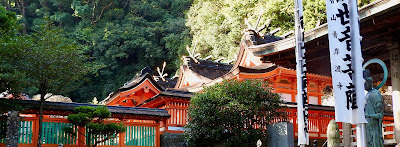 |
隣の青岸渡寺側からの本殿 (本殿を撮影しようとした写真ではありません) The main shrine from the side of the neighboring Seiganto-ji Temple. ( I was not trying to photograph the main building) |
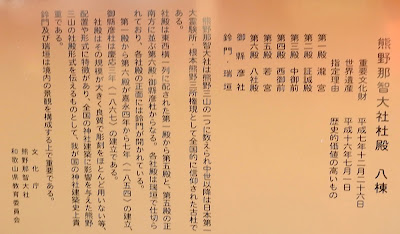
 |
| 第一殿 ~ 第五殿 2011年9月に那智大社は土砂崩れにあい、 甚大な被害を受けました。 この写真は復旧後です。 First Hall to Fifth Hall In September 2011, the Nachi Taisha Shrine suffered a landslide and suffered great damage. This photo is after restoration. 画像は下記より/ This from below ★ |
C. 御神木 / God Tree
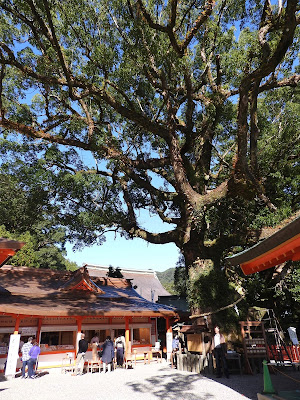 |
樟霊社 樟霊社 (ショウレイシャ) 樹齢約850年の樟 (クスノキ) が御神木 (ゴシンボク) として祀られています。 木に精霊が宿っていると考えられているのですね。 平 重盛 (タイラノシゲモリ / 1138 -1179) が 自ら植えたと伝わっています。 Shorei-sha ; Camphor Tree Shrine A camphor tree, about 850 years old, is enshrined as a God Tree. It is thought that the spirit dwells in the tree, isn't it? It is said that Taira no Shigemori (1138 -1179) planted it himself. |
幹が空洞化していて、護摩木 (ゴマギ・300円)を持って通り抜けることが出来ます。
これは'胎内くぐり'と呼ばれています。
私は、'胎内くぐり'はしていません。
今から思うと、経験すればよかったとちょっと後悔しています。
God Tree
The trunk is hollow and you can pass through with a Gomaki (300 yen).
(There are two types of Gomaki ; wooden stick, one for writing wishes and the other for writing memorial services for ancestors.)
This is called "Tainai Kuguri" ; "Go Through the Womb".
I didn't go through it.
I should have experienced it....I regret it a little.
D. 神の使者は、カラス
God's Messenger, Crow
 |
| 八咫烏・御縣彦社 御縣彦社 (ミアガタヒコシャ) は、 八咫烏 (ヤタガラス) を祀っています。 八咫烏 は熊野の神様が使役する3本足のカラスです。 八咫烏が三本足であることが何を意味するか については、諸説あります→★。 Yatagarasu ・"Miagatahikosha Hall" Yatagarasu is a three-legged crow used by the God of Kumano. It is said to be the god of guidance that leads in a better direction, and is enshrined at Miagatahikosha Hall. There are various theories about what it means to have Yatagarasu on three legs → ★ (only in Japanese, sorry).  御縣彦社 / "Miagatahikosha Hall" |
Yatagarasu is a very interesting creation.
It has appeared in various ancient literatures and also in fantasy literature.
Its ingenuity and perhaps mysterious presence while being a good guide are fascinating.
 |
| 絵カラス ここでは、絵馬が絵カラスになっています。 カラスは3本足です。 Ekarasu Ema becomes Ekarasu : Picture Crow, here. The crow has three legs. An Ema is a small wooden plaque, common in Japan, on which Shinto and Buddhist worshippers write a prayer or wish.  裏面に願いを書きますが、なんと、 これは英語で書かれていました。 その上、とても美しい文字とレイアウト、イスラトつきでした。 Somebody wrote her or his wish on the back, and it was written in English! Besides, it had very beautiful characters, layout and pictures. |
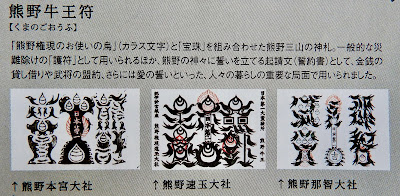 |
| 熊野牛王符 Kumano-goōfu ; Kumano Amulet Yatagarasu are used in a design. Left:Kumano Hongū Taisha Shrine, Centre : Kumano Hayatama Taisha Shrine Right : Kumano Nachi Taisha Shrine |
 |
| 八咫烏に導かれる神武天皇 (版画) 1891年、『神武天皇東征之図』より / 安達 吟光 (アダチ ギンコウ / 1853 - 1902) 画 八咫烏は、神武東征の際、高皇産霊尊 (タカミムスビ) によって、 神武天皇 (BC711 - BC 585) のもとに遣わされ、 熊野国から大和国への道案内をしました。 神武東征では、日向国 (ニュウガノクニ/ 九州) から、 大和 (現在の奈良盆地周辺)へ移動します。 Emperor Jimmu led by Yatagarasu (Print) From "Pictures of Emperor Jinmu's Eastern Expedition" ,1891 By Adachi Ginkō (1853 --1902) Yatagarasu was sent to Emperor Jimmu (BC711 - BC585) during the 'Jinmu's Eastern Expedition' to guide the way from Kumano to Yamato Province. by Takamimusubi (who is a Japanese God of Agriculture, and who was the second of the first beings to come into existence). In Jinmu's Eastern Expedition, they moved from Hyūga Province (currently on the east coast of Kyūshū) to Yamato (currently around the Nara Basin). 画像は下記より / This from below ★ |
推古天皇 (554 - 628 / 在位 : 593 - 628)の時代を記述しています]
日本国を創建する前に、神武天皇は身を清め、熊野の神の力を得ようとし、熊野入りしたのではないかと推測します。
"Kojiki" [712 / compiled by Ō no Yasumaro (? -723) ] tells that Emperor Jimmu visited Kumano Region before entering Yamato.
["Kojiki" describes history from
Empress Suiko (554 - 628 / Reign : 593 - 628)].
I think that Emperor Jimmu would purify himself and obtain the power of the Gods of Kumano, before the founding of Japan.
 八咫烏を追う(版画) 東征の先鋒として菟田(ウダ/宇陀)に向かう 道臣命 (ミチノオミノコト)。 『大日本名将鑑』より 月岡芳年 (ツキオカヨシトシ/1839 -1892) 画 Chasing Yatagarasu (Print) A priest who heads for Toda as the forerunner of Tosei. From "Dainippon Meishokan" Tsukioka Yoshitoshi ( 1839 -1892) 画像は下記より / This from below |
467段からの景色 / View from 467 Steps





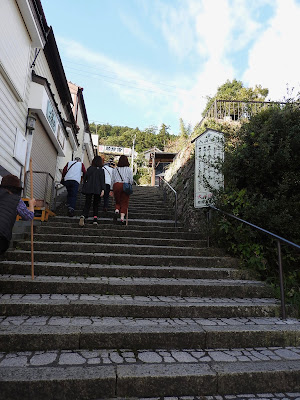






0 件のコメント:
コメントを投稿